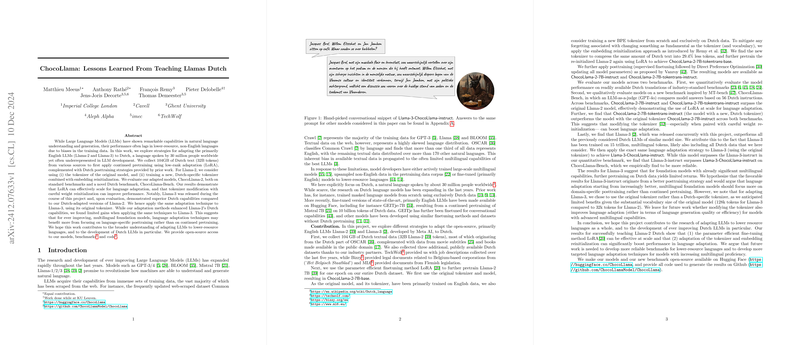Insights from "ChocoLlama: Lessons Learned From Teaching Llamas Dutch"
The paper "ChocoLlama: Lessons Learned From Teaching Llamas Dutch" presents a comprehensive exploration of adapting pre-trained LLMs – specifically Llama-2 and Llama-3 – to Dutch, a relatively lower-resource language. This work serves as a substantial contribution to the field of multilingual LLM adaptation, underlining effective methodologies to enhance non-English language performance in models predominantly trained in English.
Methodological Approach
The authors implemented several techniques to adapt LLMama-2 and Llama-3 to the Dutch language. They collected an extensive dataset consisting of 104GB of Dutch text, accounting for 32B tokens. The primary adaptation method employed is Low-Rank Adaptation (LoRA), a parameter-efficient fine-tuning approach. The Llama-2 model was first adapted using its original tokenizer, resulting in the ChocoLlama-2-7B-base. An additional adaptation included training a new Dutch-specific tokenizer with embedding reinitialization, creating ChocoLlama-2-7B-tokentrans-base.
The models were evaluated using traditional benchmarks as well as a novel evaluation tool named ChocoLlama-Bench. This new benchmark involved qualitative assessment through a series of Dutch-language prompts, aiming to provide a more nuanced understanding of the model's capabilities beyond existing quantitative measures.
Key Outcomes and Observations
The paper demonstrates that Llama-2 benefits significantly from continued pretraining with LoRA, with notable improvements in the model's capability to process and generate Dutch text. The use of a Dutch-specific tokenizer further enhanced performance, as evidenced by the metrics on ChocoLlama-Bench and other standard benchmarks. However, this adaptation method provided limited gains when applied to Llama-3, which was released during the paper and already possessed superior multilingual capabilities.
The case of Llama-3 highlights a crucial point: models with extensive multilingual pretraining datasets may benefit more from focused language-specific posttraining rather than repeated pretraining. This shift in focus is particularly beneficial when adapting models that already exhibit strong base performance in multiple languages, including Dutch.
Implications and Future Directions
The findings underscore that while parameter-efficient fine-tuning like LoRA remains effective for language adaptation, advances in foundational multilingual models potentially reduce the necessity for re-pretraining on specific languages. As LLMs become increasingly multilingual, the emphasis might move towards leveraging domain-specific posttraining to refine their abilities.
Moreover, the paper stresses the importance of developing more comprehensive benchmarks for evaluating LLMs in lower-resource languages. The introduction of ChocoLlama-Bench is a step towards better assessing the nuanced language generation capabilities beyond simple multiple-choice questions.
Conclusion
This paper illuminates important aspects of LLM adaptation for underrepresented languages. The successful adaptation of Llama-2 to Dutch demonstrates that fine-tuning strategies and tokenizer adaptations can significantly improve linguistic performance. However, for future multilingual foundation models, a greater emphasis on optimizing posttraining processes tailored to specific languages or domains may be more impactful. This nuanced approach to model development and evaluation will likely drive further innovation in the field of multilingual artificial intelligence.
By making the models, code, and data publicly accessible, the paper supports open science, allowing other researchers to build upon and extend these findings in adapting LLMs to various lower-resource contexts.
